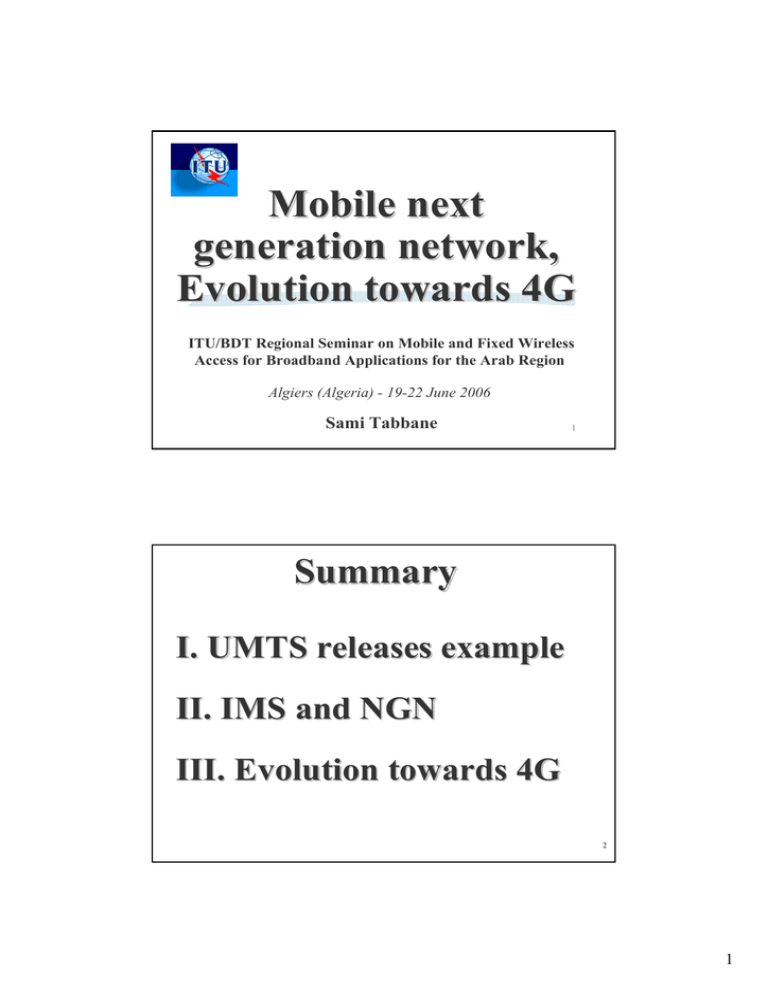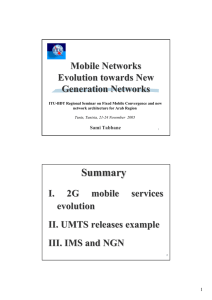Mobile next generation network, Evolution towards 4G
advertisement

Mobile next generation network, Evolution towards 4G ITU/BDT Regional Seminar on Mobile and Fixed Wireless Access for Broadband Applications for the Arab Region Algiers (Algeria) - 19-22 June 2006 Sami Tabbane 1 Summary I. UMTS releases example II. IMS and NGN III. Evolution towards 4G 2 1 I. UMTS releases example 3 UMTS Release 99 MMSC SCP MSC/VLR Billing OMC HSS GMSC SGSN GGSN PS Core CS Core Node B RNC Based on GSM and GPRS 4 2 UMTS Release 99 MMSC Billing OMC SCP HSS MSC Server GMSC Server CS GMGW MGW SGSN GGSN PS Core CS Node B RNC Control and bearer plans separation for CS 5 UMTS Release 5 MMSC Billing OMC SCP HSS MSC Server GMSC Server CSCF CS GMGW MGW CS IMS SGSN MGCF GGSN PS Core Node B RNC Introduction of IMS, IP in RAN 6 3 Core network evolution 2 main features Server Gateway • Border network • Features: ¾ Media resources, ¾ Switching/Routing, ¾ Media conversion, ¾ Option: signaling. • Layer control • Features: ¾ Mobility management, ¾ Call control, ¾ Security, ¾ Billing. • Examples: MSC Server, SGSN • Examples: Wireless Gateway, Fixed Gateway, IP Gateway Server, CSCF (Call State Control Function), Media Gateway Control Function (MGCF). 7 UMTS services Classes Types of services Conversational Constraints Voice, video Real time Streaming File transfer (video sequence downloading) Synchronism between entities Interactive Sessions (Web, databases access, …) Low BER Background SMS, e-mail, FTP Low BER and low delay constraints Area Picocells Buildings Microcells Urban Bitrates Speed 2 Mb/s Low 512 kb/s 120 km/h Macrocells Rural and suburban 144 – 384 kb/s 500 km/h Satellite coverage Rural and suburban 9,6 kb/s 120 km/h 8 4 UMTS Release 5 features HSDPA (1 - 5 Mb/s mean throughput) CAMEL 4 IMS (VoIP, chatt, games, white shared board, flexible billing, …) Wideband AMR (larger band for voice) SIP (call control) Smart antennas OSA improvements (VAS offers from third parties, VHE eased) GTT (Global Text Telephony, real time conversation) Extended streaming (optimisation, 2 and 3D graphics, MIDI, …) LCS improvements with A-GPS IP transport in UTRAN (IP-RAN) with DiffServ introduction End to end QoS enhancements MMS/EMS enhanced IuFlex (load sharing among core network nodes). 9 Release 6 features MBMS IMS phase 2 (access independant from access network UMTS, GERAN, WLAN) SES (Speech Enhanced Services): distributed speech recognition MIMO WLAN (loose coupling) with AAA features reuse, access with USIM Terminal management (configuration, performances, downloading) Presence and Instant Messaging 10 5 Services evolution in UMTS R99/R4/R5/R6 networks Release R99 R4 R5 R6 Services MMS, streaming, LCS (cell), MExE, SAT, VHE, TrFO, VHE, OSA, LCS in PS and CS, VoD, IMS, HSDPA, Wideband AMR, GTT MBMS, IMS phase 2 Voice/Videophony Voice/Videophony Voice SMS/MMS Voice Messaging Videophony IM/Presence Instant Messaging/Presence Messaging Rich Call Services RCS Messaging LCS GTT 11 III. IMS and NGN 12 6 NGN definition ITU Rec. Y.2001 “General overview of NGN” (Dec 2004): An NGN is a packet-based network able to provide telecommunication services and able to make use of multiple broadband, QoS-enabled transport technologies and in which service-related functions are independent from underlying transport-related technologies. It enables unfettered access for users to networks and to competing service providers and/or services of their choice. It supports generalized mobility which will allow consistent and ubiquitous provision of services to users. 13 NGN definition Separation of: Access Layer Transport Layer Control Layer Service Layer with Control & Transport Layers being shared by: different access types (RAN, Fixed…) service layers with Packet (ATM, IP) Transport converging toward IP transport for provision of Multimedia Services (Real Time, Presence, Messaging, Voice, Video, Data...) 14 7 NGN convergence model Video services (TV, movie, etc.) Data services (WWW, e-mail, etc.) Telephone services NGN services Point to point, PTM, MTM NGN transport Point to point, PTM, MTM 15 IMS characteristics Principles • QoS characteristics differentiation: voice calls, videophony, associated to a multimedia session (streaming, IM, etc.) • Separation of the planes: IP data and session control (SIP) • Independancy from access network IMS for mobile networks Packet GPRS, EDGE, UMTS & CDMA2000 Non real time services R5 Plate-forme for multimedia IP applications Based on IETF specifications IMS extended to fixed networks (xDSL, WLAN, cable, …) with media gateway R6 Support of services convergence on fixed and mobile networks (conversion CS voice traffic into IP) 16 8 Componants and interactions between IMS and other networks IMS RAN Application Servers (SIP, OSA, CAMEL) Session Control Transport Signaling Media Control SIP ISUP Voice network RNC Media Gateway User Data Core packet Packet Support Node IP backbone SIP Packet network Packet Gateway S-CSCF (Call Status Control Function): central IMS componant; SIP AS (SIP Application Server): provision of the logic associated with the VAS; OSA SCS (Service Capability Server) gathers one or several features; IM-SSF (Inter-working Module) : SIP-CAMEL interworking; CSE (Camel Service Environment): SCP using CAMEL and GSM (GSM SCF) features; HSS (Home Subscriber Server): same as HLR for IMS 17 IMS in UMTS Allows operators to have more control on the service level than with GPRS only: Service level awareness Correlation between the SIP application layer and the transport in PS domain Access to services in correlation with a subscription profile (e.g. basic, silver, gold…) Better control on the packet resources used 3GPP IMS Releases: Release 5: frozen since March 2003 Release 6: frozen since December 2004 Release 7: target to freeze end 2005 18 9 IMS R5 features Allows the différentiation of QoS characteristics associated to a multimedia, voice call, or videophone session: conference calls, access to streaming contents, presence, video messaging, Instant Messaging, push services, content sharing, web browsing, file download, ¾ Flexible billing: billing per service, connectivity, QoS, duration, destination – volume; billing per content, images, news, books. ¾ Example: add/suppress componants such as video, audio, whiteboard on-line sharing. 19 IMS R6 enhancements - Identity portability: Portability of the identities when changing operator - VoIP over HSDPA (allows the use of IP for voice transportation during a handover with a better QoS during HO). 20 10 Transition to NGN (1) NGN advantages: - Transport network simplification (common CS/PS backbone), - No transit layer, - Common signaling (signaling over IP, SIGTRAN), HSS SCP MSC Server MSC Server VLR SCP PS Backbone MGW MGW RNC Node B MGW MGW … RNC Node B 21 Transition to NGN (2) NGN advantages: - Transport network simplification: R5 common CN/RAN backbone, HSS SCP MSC Server VLR SCP MSC Server PS Backbone MGW Node B MGW MGW RNC MGW … RNC Node B 22 11 IV. Evolution towards 4G 23 4G - What is it? ¾ 4G = 4th Generation mobile communications ¾ 4G = B3G = Beyond 3rd Generation (UMTS, IMT-2000) mobile communications ¾ Foreseen to become available after 2010. ¾ ITU Recommendation ITU-R M.1645: Systems beyond IMT-2000 will be realized by functional fusion of existing, enhanced, and newly developed elements of IMT-2000, nomadic wireless access systems and other wireless systems, with high commonality and seamless interworking. = mix of many interacting systems is foreseen - not one standard. ¾ Targeted data rates (with wide area coverage and significant mobility) are in the area of 50 to 100 Mbits/s. 24 12 Motivations Wider Bandwidth Global mobility and service portability difficult due to different standards hampering Primarily Cellular (WAN) with distinct LANs’; need a new integrated network Apply recent advances with spectrally more efficient modulation schemes Need all all digital network to fully utilize IP and converged video and data 25 Key 3G and 4G Parameters Attribute 3G 4G Major Characteristic Predominantly voice- data Converged data and VoIP Network Architecture Wide area cell based Frequency Band 1.6 - 2.5 GHz Hybrid – integration of Wireless Lan (WiFi), Blue Tooth, Wide Area 2 – 8 GHz Component Design Bandwidth Data Rate Optimized antenna; multi-band adapters 5 – 20 MHz 385 Kbps - 2 Mbps Smart antennas; SW multi-band; wideband radios 100+ MHz 20 – 100 Mbps Access Forward Error Correction Switching Mobile top Speed WCDMA/CDMA2000 Convolution code 1/2, 1/3; turbo Circuit/Packet 200 kmph MC-CDMA or OFDM Concatenated Coding IP Multiple versions All IP (IPv6.0) Operational ~2003 ~2010 Packet 200 kmph 26 13 Definition Completely new fully IP-based integrated system of systems and network of networks achieved after convergence of wired and wireless networks as well as computers, consumer electronics, and communication technology and several other convergences that will be capable to provide 100 Mbps and 1 Gbps, respectively in outdoor and indoor environments, with end-to-end QoS and high security, offering any kind of services at any time as per user requirements, anywhere with seamless interoperability, always on, affordable cost, one billing and fully personalized. 27 Radio technologies for B3G systems o MIMO (Multiple-Input Multiple Output) technology o Link adaptation techniques o Multi-carrier based modulation and access (OFDM/OFDMA) o Iterative (multi-user) processing o “Cross-layer” optimization and design principles o Ultra-WideBand (UWB)...? 28 14 Convergence is what 4G is about 29 Concluding remarks 4G, convergence: networks, technologies, applications and services, Personalized and pervasive network to the users. Full IP and one unique core network. Services, applications, transport, access separation (NGN) approach. Convergence is the disruptive concept of 4th generation mobile networks. 30 15


